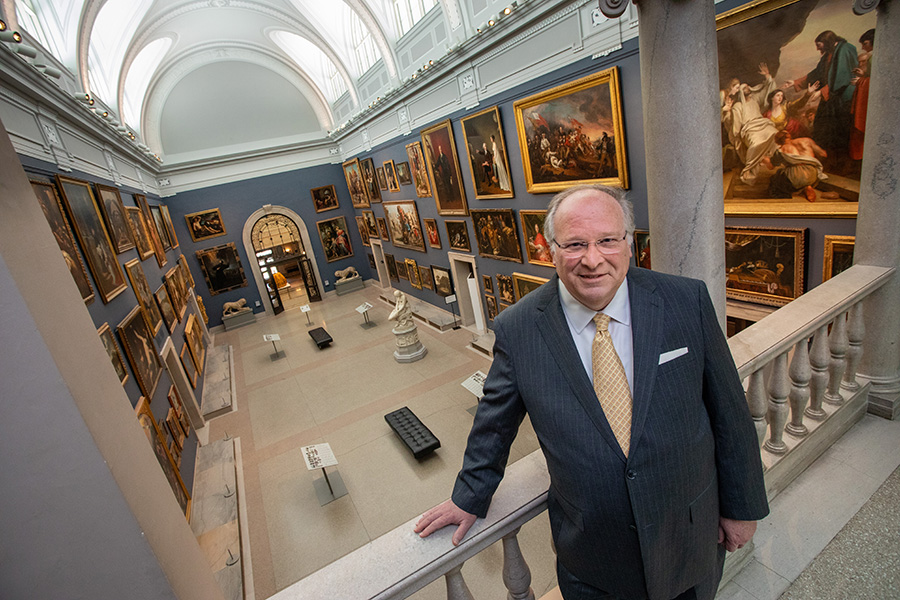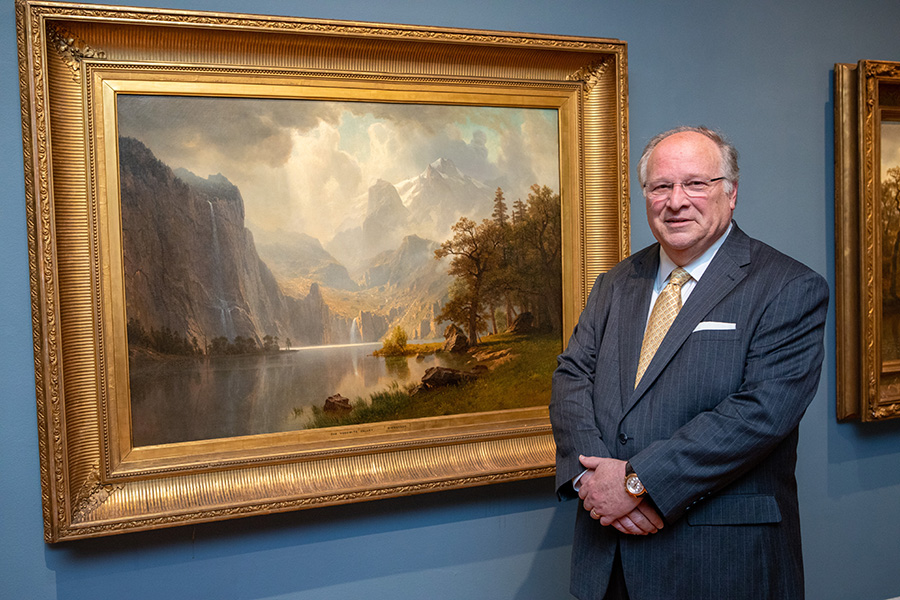- Apply
- Visit
- Request Info
- Give



Published on October 18, 2023

Jeffrey Brown ’79 never expected to work at a bank. And he never expected to work at Newman’s Own, the nonprofit food company, or at an art museum.
But his career has taken all those turns, and its latest twist has placed him at the head of one of Hartford’s premier cultural institutions, as chief executive officer of the Wadsworth Atheneum Museum of Art.
“I’ve always been thrown into situations that are new and different, and I’ve found it invigorating,” he said. “We can’t be afraid of the doors that are open.”
As CEO of the Wadsworth, he’s in a particularly unusual role. Traditionally, art museum directors come from curatorial backgrounds. Thomas Loughman, the Wadsworth’s director from 2016 to 2021, for example, was a European art historian who had been a curator at the Philadelphia Museum of Art and the Phoenix Art Museum, among others. But when Loughman left, the Wadsworth turned to an unusual hybrid leadership structure.
Brown, a member of the Wadsworth Board of Trustees since 2012, was named interim director and CEO and later permanent chief executive officer to oversee leadership, vision and the strategic direction of the museum. Matthew Hargraves, a specialist in British art who had been an interim chief curator at the Wadsworth, was then made director, overseeing the museum’s artistic direction and reporting to Brown.
This “distributed leadership model,” as the museum describes it, was pioneered in 2017 by The Metropolitan Museum of Art in New York City, and the Wadsworth consulted with “The Met” about it before adopting the model. The Met recombined the two roles with an art historian this past summer, however, when the chief executive officer left.
“I’m possibly the only CEO of a major art museum in the United States who is not an art historian,” said Brown.
The dual leadership model allows the Wadsworth to retain artistic integrity and take advantage of needed management skills, he noted. “We are in discussion with other museums who are considering this structure,” he added. Art museums have often had autocratic structures, he said. “The culture of art museums is very resistant,” but the dual structure is “an opportunity for a big dialogue.”
At the Wadsworth, a series of setbacks over governance, staff turnover and failed expansion plans over the past 20 years, followed by closures during COVID, have gradually been turned around. The past two directors had tenures of five and eight years, not short by today’s art museum standards, Brown pointed out.
“Things are much calmer here now,” he said.
Brown joined the museum’s Board of Trustees in 2012 when he was an executive of Webster Financial Corp. He had been on the board of The Bushnell Center for Performing Arts and is still an honorary trustee there. These cultural institutions are “anchors to the Greater Hartford community,” he said. He envisions a future for the museum that “helps people see themselves in the art as they go through.” It is important for cultural institutions to reflect the population they serve, he added.
European and American art dominate the collections of the Wadsworth, the oldest continuously operating public art institution in the United States. Among its collections are works by Caravaggio, Joan Miró, Joseph Cornell, Jackson Pollock, the Morgan collection of Greek and Roman antiquities, the Wallace Nutting collection of American colonial furniture, the Samuel Colt firearms collection, and European and American Impressionist paintings.
But the collections are much broader than just European and American art, Brown said. With much of the artwork in storage, “we’re constantly discovering new works” and putting them on display, he added. Museums today need to evolve in their presentations, he said. Part of that is showing digital works.
A recent exhibit, “I Am Seen, Therefore, I Am: Isaac Julien and Frederick Douglass,” curated by Harvard professors Henry Louis Gates Jr., and Sarah Lewis was an immersive audio-visual presentation on five screens of Douglass’s reflections on race and citizenship, juxtaposed with contemporary work from Julien, a British filmmaker and installation artist. It commemorated Douglass’s first visit to Hartford in 1843 and was presented in collaboration with The Amistad Center for Art & Culture, which is housed at the museum.
 The museum also has the most diverse staff that it has ever had, Brown said. “But you can’t just diversify the staff,” he said. Engaging with the public in new ways but remaining true to the museum’s intent is part of his vision.
The museum also has the most diverse staff that it has ever had, Brown said. “But you can’t just diversify the staff,” he said. Engaging with the public in new ways but remaining true to the museum’s intent is part of his vision.
Integrating displays with artworks that have traditionally been shown separately is a new direction for the Wadsworth. The costumes and textiles collection, decorative arts and other works are increasingly being shown alongside paintings from the same eras, providing cultural context.
The museum has also ventured into areas it had spurned in the past, such as a contemporary glass exhibit last year during the International Year of Glass.
None of this was in Brown’s imagined future when he was a public policy major at Eastern in the early 1980s. He was in one of the last classes to be housed in the Nathan Hale on Main Street, where he roomed with Bob Molta, now Eastern’s sports information director. Eastern had a much smaller campus then, Brown recalled.
“It was a great experience — I still have a core group of friends who went there.”
Brown is now a director on the ECSU Foundation board, and President Elsa Núñez is a trustee for the Wadsworth.
Brown earned an M.B.A. at Rensselaer Polytechnic Institute in Hartford, then became a trainee at Hartford National Bank. He spent the next 35 years in banking and was a senior executive at Webster Financial Corp., but after the 2008 financial crisis in banking, he decided it was a good time to leave.
“I knew I had one more chapter to write, and I wanted to give back,” he said. He joined Newman’s Own, where he was an executive for about nine years and was about to retire when he was asked to take over as interim CEO and director at the Wadsworth in 2021. His leadership in the interim role was described by another trustee as “a master class in thoughtful and effective management,” and he was then made the permanent CEO.
The connecting tissue in his career has been curiosity. In his commencement speech to Eastern graduate students this past spring he urged graduates to “approach each responsibility with a sense of curiosity.” A management class he took at Eastern as a business minor stimulated his own curiosity about what made management tick, Brown said.
He also urged graduates to always be ready to challenge the status quo by asking, “Why not?”
At Newman’s Own, he recalled, Paul Newman would not give up on making the company’s salad dressing with all-natural ingredients, even when he was told that was not possible.
“The company was successful because he was curious,” Brown said, and willing to explore how to make the product he envisioned.
In banking, he once had to move from marketing to assume a chief information officer position on short notice, when the previous CIO left. “I did a lot of fast learning,” he said.
At the Wadsworth, where the collections cover 55,000 items spanning 5,000 years of human history, his curiosity has full reign, Brown said.
“Can you imagine a better environment in which to be curious and question the status quo?”
Written by Lucinda Weiss